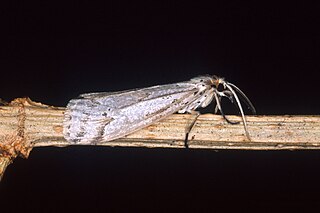
Yponomeutoidea is a superfamily of ermine moths and relatives.

The Acrolepiidae are a family of moths known as false diamondback moths. In modern classifications, they are often treated as a subfamily (Acrolepiinae) of the family Glyphipterigidae.
Günther Edmund Maul was a German ichthyologist and taxidermist in Portugal. Maul came to Madeira in December 1930 to work as taxidermist at Museu Municipal do Funchal, which opened to the public in 1933. He was appointed director for the museum in 1940, a post that he held to his retirement in 1979. He, however, continued his research until shortly before his death. He started two journals and opened the museum's aquarium to the public in 1959. He also participated in several expeditions including with the French bathyscaphe Archimède in 1966 and organised the first multidisciplinary expedition to the Salvage Islands in 1963. He was awarded an honorary doctorate from the University of Madeira in 1995.

The leek moth or onion leaf miner is a species of moth of family Acrolepiidae and the genus Acrolepiopsis. The species is native to Europe and Siberia, but is also found in North America, where it is an invasive species. While it was initially recorded in Hawaii, this was actually a misidentification of Acrolepiopsis sapporensis.

Acrolepia is a genus of moths in the family Acrolepiidae.

Acrolepiopsis is a genus of moths in the family Acrolepiidae.
Prochoreutis diakonoffi is a moth of the family Choreutidae. It is known from Shaanxi, China and from Honshu, Japan.
Prochoreutis holotoxa is a moth of the family Choreutidae. It is known from China (Shanxi), France (Alps), Italy, Austria (Tirol), Switzerland (Zermatt), Romania and Russia (Siberia).

Digitivalva reticulella is a moth of the family Acrolepiidae found in most of Europe, except Ireland, Great Britain, the Netherlands, France, Portugal, Slovenia, much of the Balkan Peninsula, and Lithuania.
Digitivalva hoenei is a moth of the family Acrolepiidae. It is found in China (Yunnan).
Digitivalva asiatica is a moth of the family Acrolepiidae. It is found in China.
Acrolepiopsis deltoides is a moth of the family Acrolepiidae. It is found in China (Zhejiang).
Digitivalva kasachstanica is a moth of the family Acrolepiidae. It is found in Kazakhstan.
Acrolepiopsis leucoscia is a moth of the family Acrolepiidae. It was described by Edward Meyrick in 1927. It is found in the central United States, from Texas north to Illinois, Missouri and Ohio.
Acrolepiopsis incertella is a moth of the family Acrolepiidae. It is found in the eastern half of North America, from southern Ontario to Florida and Mississippi in the south and to Illinois and Michigan in the west.
Acrolepiopsis reticulosa is a moth of the family Acrolepiidae. It is only known from two widely separated locations in Wyoming and New Mexico.

Tinagma balteolella is a moth in the Douglasiidae family. It is found in Great Britain, France, Belgium, the Netherlands, Germany, Switzerland, Austria, Italy, Spain, the Czech Republic, Slovakia, Croatia, Hungary, Romania, Poland, Lithuania and Ukraine. It is also found in Morocco and Jordan.

Tinagma anchusella is a moth in the Douglasiidae family. It is found in Denmark, Germany, Austria, Poland, Bulgaria, Greece, Estonia, Latvia, Sweden, Ukraine and on Cyprus. It is also found in Turkey, Jordan and the Caucasus region.
Tinagma minutissima is a moth in the family Douglasiidae. It is found in Turkey, Ukraine and Russia (Volgograd).
Epermenia sinica is a moth in the family Epermeniidae. It was described by Reinhard Gaedike in 1996. It is found in Yunnan, China.






